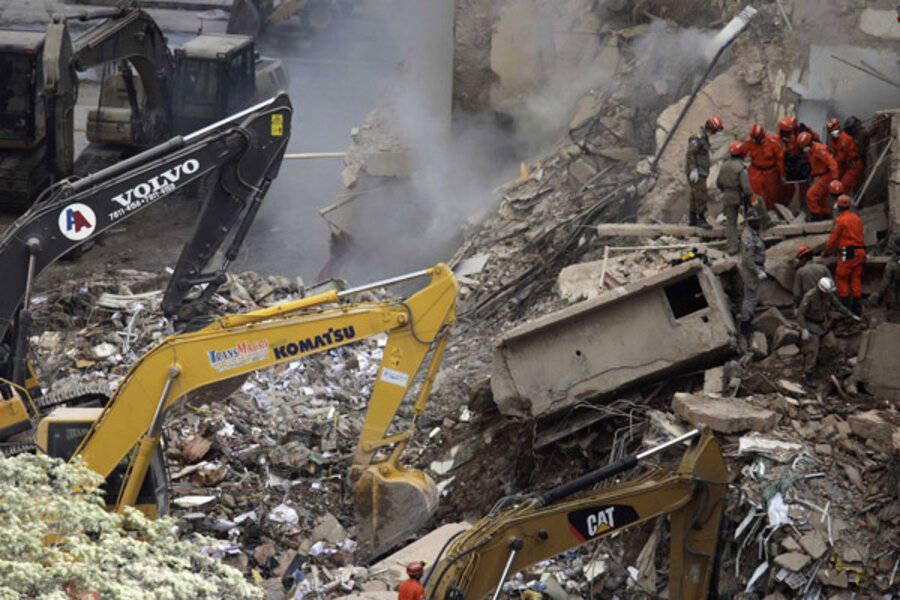Rio building collapse: Will Brazil be ready for the Olympics?
Loading...
| São Paulo, Brazil
The collapse of three buildings in the center of Rio de Janeiro sounds a sharp cautionary note for Brazilians as the country rushes to build homes, hotels, transports links, and other infrastructure projects ahead of the 2014 World Cup and 2016 Olympics.
Three people have been reported dead and 19 missing after the buildings came down late Wednesday night, reportedly after a loud explosion. Because of the time, the buildings were largely empty when they collapsed. Rescue workers with sniffer dogs continued to dig through the rubble Thursday morning looking for any survivors.
Officials are pointing to potentially shoddy work as a cause, highlighting what has been an ongoing concern about construction and infrastructure in South America's biggest nation – and the world's sixth-biggest economy.
“There was probably a structural failure in biggest building – of 20 stories – that led to the collapse of the two smaller buildings of 10 and four stories,” said Rio de Janeiro Mayor Eduardo Paes.
Even at the highest levels, Brazil’s infrastructure projects are routinely late, poorly built or over budget, or all three. Stadiums for the World Cup were late to get started and public transport, particularly airports, are frequently chaotic.
[ Video is no longer available. ]
New metro lines open only during the middle of the day because they are not ready for rush hour, potholes appear in new highways within weeks of opening and even brand new, multimillion dollar buildings are inaugurated only for cracks to appear in the walls days later.
Perhaps the most emblematic project of the "new" Brazil, the proposed bullet train between the Rio de Janeiro and Sao Paulo, was supposed to be ready for the 2014 World Cup, or at least the 2016 Olympics. Instead, its budget has ballooned and foreign firms have shied away from getting involved. Not a single meter of track has been laid.
And over the past year, more than 60 manhole covers in Rio have exploded, injuring dozens of people and damaging windows and cars.
Major push to build housing
Brazil's housing crisis is adding to pressures. The country needs some 15 million houses to meet demand.
Since 2009, when it announced the start of the Minha Casa, Minha Vida, or My House, My Life program, 700,000 new homes have been handed over to the poor. Another 2.3 million are either being built or are on the drawing board. Investment should top $100 billion on new homes, with another $28 billion to be spent on removing and upgrading the notorious favelas that house at least 11 million people.
Under the Minha Casa, Minha Vida program, most of the houses would go to families whose monthly income is less than 1,600 reais, around $900. The rest will go to families earning up to 3,100 reais (approx. $1,750).
The houses are heavily subsidized, with new owners paying 10 percent of their salary over a set period of up to 25 years.
“This is the first time that the government has invested massively in urbanization on such a grand scale,” said Inês Magalhães, Brazil’s Housing secretary. “That is important as the object is to recuperate those spaces lost due to the lack of an effective plan for housing.”
But the quality of those homes has been criticized.
Here in Franca, where the homes were built under a separate program, as well as at a Minha Casa, Minha Vida development in nearby Ribeirao Preto, problems have arisen.
In the latter, residents are already threatening to turn the neat rows of houses into a favela, or slum. Within days of moving in, some have turned their front rooms into stores selling drinks and staples and are building garages and ugly cinder block walls on or round their front gardens.
At the former, roads and surrounding walls haven’t been built and seven months after moving in residents are still waiting for basic repairs to take place.
“I’d say that 95 percent of these houses have problems,” said Juliana dos Santos, one of the residents who has tried to organize protests. “[This place] would be an enormous source of pleasure for me if it wasn’t for these problems.”
The company responsible, Emes Construtora, said the problems were "minor" and "normal" and promised it was working on resolving them. The state’s housing director said the problems were much greater than that and promised to investigate.
The auditor sent to review the problems agreed said more care must be taken to ensure quality matches ambition.
“The company in charge said they would sort out these problems and they haven’t,” said Orlando Naves, an auditor with the Sao Paulo state government. “How can you hand over new houses when the roads aren’t even paved?”
* Correction: An earlier version of this story had an incorrect dateline.







